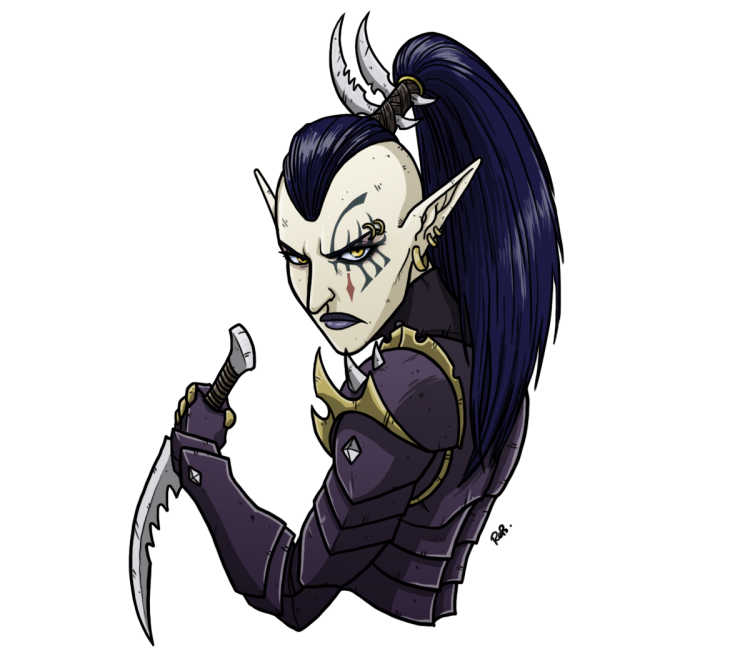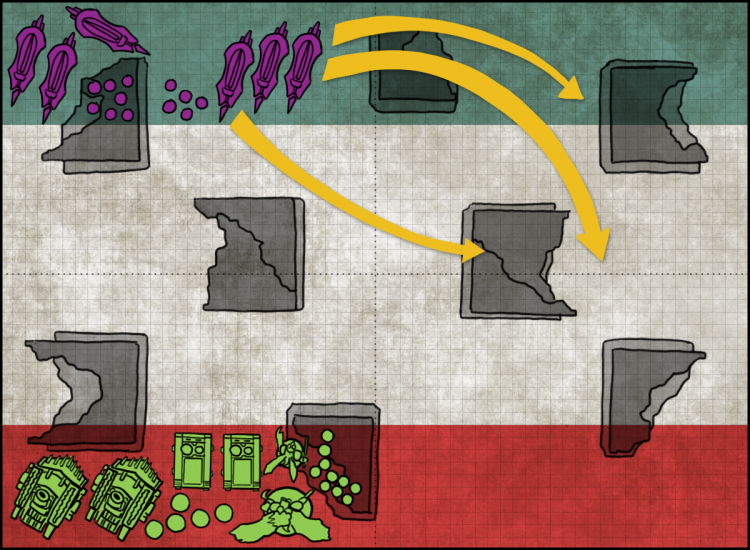Welcome back readers, to Keys to the Spire. I, Skari, Ancient Archon, have returned at the behest of the Mon-keigh here at Goonhammer to provide more of the dark secrets of the Drukhari. In today’s article we’ll be tackling more intermediate concepts about the newly updated faction, with an eye toward what you need to know if you’ve been playing Drukhari for a while.
If you missed part 1, you can find it here.
Part 2 : What To Know if you have been playing Drukhari for a while
At this point you have either continued to play the Drukhari and have some games under your belt, or you’re a returning veteran of prior editions. Your influence in the Dark City grows and your enemies amass in the shadows. The Drukhari, as we learned in the previous installment, play differently to almost every faction in the game, relying on three main elements – speed, mobility and damage potential – however they are quite fragile and like a house of cards can come crashing down to a light breeze. We shall now discuss some of the more nuanced characteristics of the Dark Eldar, and then in our last segment, we shall break down some of the fun tips and tricks that even an old Archon like me uses to achieve my nefarious goals.
Economy: It’s All About the Trades
Last time I talked about how Drukhari hit hard but are fragile. When you play drukhari you want to make sure that you are using your units as a resource. The army works well when you adopt or internalize a trade system, akin to chess. That is, you can think of using a piece in your army to remove an enemy piece, and then expect the enemy to take the piece you just used. You’ll use this method often, especially when you’re trying to take objectives away from the enemy, sacrificing a small unit of kabalites or wyches to get in the way, move block, or tie up an enemy unit or tank in close combat.

Another army that does this well are Sisters of Battle (the Adepta Sororitas) and you may have seen how they do this with units like Repentia and Zephrym. In a similar fashion you can use a 100-point unit of wyches to charge in, tie up, kill, fight twice, or do whatever needs to be done to ultimately kill or pin down 200+ points worth of the enemy army (using stratagems from the Book of Rust to boost their effectiveness, for example). You’ve already made a positive trade but then your opponent is forced to retaliate and deal with the threat, expending even more resources to remove the unit. Even if the Wyches die, they have effectively tied up three times their cost in resources and points from the enemy. That’s a great trade.If you do this every turn, your opponents will continue to lose units at a faster rate, and they’ll run out of units and lose the ability to respond much faster than you will.
Winning the trade game can sometimes come down to who commits to the middle of the board (or who gets more aggressive) first, but with the Drukhari you can have it either way: If you go first, you have the speed to really get aggressive if you need to with multiple transports filled with units, pressing directly into your opponent’s lines. If you are on the defensive, you can (and should) screen out with cheaper units, to entice (or force) the enemy to charge out to clear them out with their faster, higher-damage units like Vanguard Veteran. This leaves them open to being charged by a cheaper, more efficient Drukhari unit, allowing you to make another advantageous trade.
Speed: Deploying Effectively
Another key topic in Part 1 was speed. Speed is one of the core advantages of the Drukhari force. Because Drukhari are so fast, you can use deployment as a tool to entice your opponents to deploy out-of-position, pulling them off-balance. You can for example place most of your army on one side of the table during deployment – usually behind the best piece of terrain on the table and close to objectives that you will have to take through the day. Your opponent, playing a slower force, will want to deploy accordingly, in order to be able to engage with or reach your units. But that’s where you want them – the aim is to entice your opponent to face off on the same side of the table.
Once the game starts, you can use your speed to move almost to a completely different part of the table. Dark Eldar are one of the only armies that have the necessary speed to do actual physical laps of the table with their units. By contrast your opponent’s slower, more powerful units may be in bad positions near the edges of the table, forcing them to sit helplessly and watch as you use your speed to zoom as far away from them as possible and pick them off from a distance or just avoid them for a few turns.

This also works if your opponent pushes heavy into the middle of the table, particularly if they have a slower army. You can deploy on the table edges and “skirt” the board to put more distance from slow damage dealers like Deathwing Knights or Deathshroud Terminators. As a Drukhari army you should always be thinking about how you can use the Deployment Step to your advantage and how you can use your speed to re-deploy your army to a whole new area of the table if needed, then try again one turn later. We are one of the only armies that can do this.

Picking Your Targets: Prey On The Weak
This is not just the name of a fantastic stratagem in the Dark Eldar codex – it’s also a cornerstone of your strategy. One of the things effective Drukhari generals do very well is making sure they focus on one enemy unit at a time to the exclusion of all else until it is destroyed. We do not like to fight fair and your tabletop strategy shouldn’t either – “Overkill” is the name of the game and you need to make sure that you take this to heart. Do not split your fire unless absolutely necessary and make sure you have multiple units able to take aim at your targets so that destruction is a foregone conclusion. For example, consider a situation where you have an enemy rhino full of delicious targets. You could have two dark lances fire at it and hope for the best, but the smart general sets themselves up to be able to take aim with 5-6 anti-tank weapons like dark lances, blasters, and blast pistols. This ensures the vehicle will be destroyed, stranding the delicate occupants and leaving them vulnerable to the rest of your forces.
The key to optimizing this process is to begin by shooting with the units that do not have a choice in the matter. So for example, if my Archon with a blast pistol only has one target I will begin shooting with him because he does not have any other options, and then I work my way from unit to unit, focusing my fire on the one target that I need to take down, shooting first with units that have fewer choices and moving down the line to those that have more target options. This ensures that once the initial target has been eliminated, the remaining attackers can choose other targets for their weapons.

The other part to this is to make sure that you position yourself in a way to mitigate enemy retaliation. Use your movement and speed to make sure that the enemy units that you are not going to target will have a hard time getting lines of sight and range to your aggressively positioned units. By doing this you’ll reduce the chances of an enemy being able to fully retaliate while you pick apart their army one piece at a time.
Next Time: Tips and Tricks for Taking Your Game to the Next Level
Today’s article was but a fraction of the knowledge I have gathered from playing and piloting the Dark Eldar on the table for over 12 years. While the units, missions, and points may change, these maxims have stayed the same, edition after edition, codex after codex, through many hundreds of games. The application of force, effective deployment of troops, and the ability to win the trading game are paramount to your experience as you unlock the secrets of the Spire. Join us on Monday for the third and final segment, where I shall discuss some of the tips and tricks for getting the best results with the Drukhari in this edition.
You can read more from Archon Skari on The Art of War 40k or follow his exploits on YouTube.
If you have any questions or feedback, drop us a note in the comments below or email us at contact@goonhammer.com.


